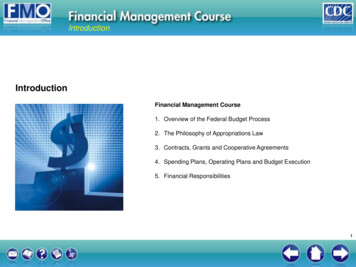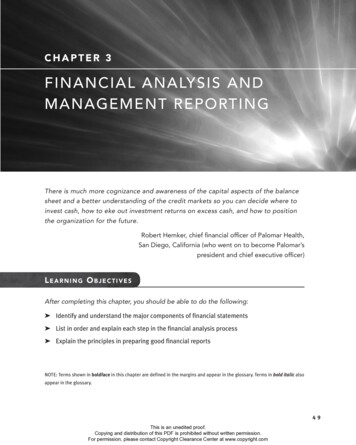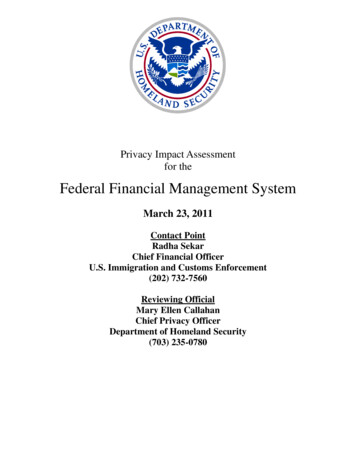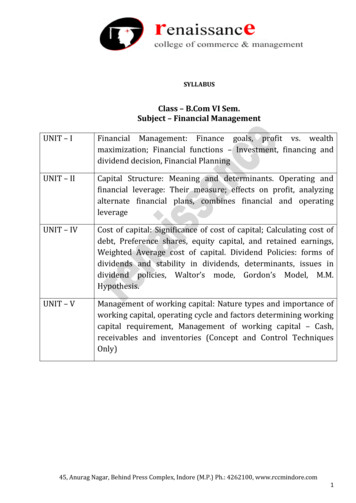
Transcription
IntroductionIntroductionFinancial Management Course1. Overview of the Federal Budget Process2. The Philosophy of Appropriations Law3. Contracts, Grants and Cooperative Agreements4. Spending Plans, Operating Plans and Budget Execution5. Financial Responsibilities1
Module 1: Overview of the Federal Budget ProcessModule 1 Objectives Identify the major legislation that affects the federalbudget process. Know the phases of the budget process and timeline. Recognize the purpose of an operating plan.2
Module 1: Overview of the Federal Budget ProcessThe Budget and AccountingAct of 19211921 Requires the President of the United States to submit anannual budget proposal and a statement of thegovernment’s financial condition to Congress. Includes a budget message and a summary of reportinginformation on past and future budgets. Established the Bureau of the Budget, now known as theOffice of Management and Budget (OMB), which providesresources to produce the President’s budget. Established the General Accounting Office now known asthe Government Accountability Office (GAO) to provideCongress with resources to ensure accountability.3
Module 1: Overview of the Federal Budget ProcessGovernment Performance andResults Act of 1993 (GPRA)The primary legislative framework includes three main components:Strategic Plan Mission statement General goals and objectives (outcome related)Performance Plan Measurable performance goals by program activity Operational processes, technology, human capital, and otherresources required to meet the performance goalsPerformance Report Compare actual program performance achieved to the performancegoals and indicators in the plan Performance indicators: output, outcome, efficiency, and effectiveness Provide explanations if goals were not met4
Module 1: Overview of the Federal Budget ProcessGPRA Modernization Act of 2010The primary legislative framework includes the following goals: Adopt a more coordinated and crosscutting approach to achieve common goals Address weaknesses in major management functions Ensure that performance information is both useful and used in decision making Instill sustained leadership commitment and accountability for achieving results5
Module 1: Overview of the Federal Budget ProcessThe Anti-deficiency Acts of1921 and 1950Congressional “Power of the Purse”1. Prohibits the obligation or expenditure of government funds inexcess of the amounts appropriated by Congress or in excess ofamounts permitted by regulations.2. Forbids the obligation of any funds before the appropriation ispassed.3. Requires a funds control system for making obligations.6
Module 1: Overview of the Federal Budget Process6 Phases in the FederalBudget Process1. Strategic Plan: Identifies new initiatives as well as expandsexisting programs.2. Formulation: Prepares budget estimates and justificationsbased on guidelines provided by Congress, OMB and Healthand Human Services(HHS).3. Presentation: Justifies budget request before Congressand responds to questions.4. Execution: Develops apportionments, spending plans,allotments, allowances, and obligates funds.5. Performance: Evaluation and Analysis – determines if theexpected results were achieved.6. Future Strategic Direction: Performance results determinefuture funding decisions.7
Module 1: Overview of the Federal Budget ProcessThe Federal Budget ProcessSTRATEGIC PLANNINGDefine recommendations forfunding and prioritiesEVALUATING RESULTSBUDGET FORMULATIONPrepare budget estimates andbudget justificationsReviewed and approved byHHS & OMBCOST/BENEFIT ASSESSMENTWHAT PRODUCES THEBEST VALUE?BUDGET PRESENTATIONPERFORMANCECongressional hearing,respond to formal questionsform appropriationsubcommitteesTRACK THE PROGRESSOF ACHIEVING OUTCOMESBUDGET EXECUTIONApportionment of funds,obligations incurred8
Module 1: Overview of the Federal Budget ProcessThe Federal Budget TimelineFY 2014FY 2013 FY sDecNovOctSepAugJulJunMayAprMarFebJanDecNovCY 2013OctSepAugJulJunMayAprMarFebJanDecNovCY 2012OctSepAugJulJunMayAprMarFebJanCY 2011AppropriationBillsMarkupSelection of Program InitiativesCDC/HHS/OMB Budgets, President’s Budget, Congressional BudgetCommittees Hearings, Q&As, House & Senate Reports, Appropriation BillApportionments, Spending Plans, Allotments, AllowancesAnalysis and Evaluation and inform the Future Strategic Direction9
Module 1: Overview of the Federal Budget ProcessThe Federal Budget TimelineFY 2014FY 2013 FY sDecNovOctSepAugJulJunMayAprMarFebJanDecNovCY 2013OctSepAugJulJunMayAprMarFebJanDecNovCY 2012OctSepAugJulJunMayAprMarFebJanCY 2011AppropriationBillsMarkupSelection of Program InitiativesCDC/HHS/OMB Budgets, President’s Budget, Congressional BudgetCommittees Hearings, Q&As, House & Senate Reports, Appropriation BillApportionments, Spending Plans, Allotments, AllowancesAnalysis and Evaluation and inform the Future Strategic Direction10
Module 1: Overview of the Federal Budget ProcessStrategic Planning PhaseFY 14OctSepAugJulJunMayAprMarFebJanDecNovCY 2013OctSepAugJulJunMayAprMarFebJanCY 2012FY 2015 Administration goals, themes, & initiatives (includesPresident and Secretary) CDC-wide priorities & mission-related activities Congressional priorities Constituent & partner priorities Government Performance and Results Act (GPRA)11
Module 1: Overview of the Federal Budget ProcessBudget Formulation Phase Stage 1 (April - July) Stage 2 (August – November) Stage 3 (December – February)12
Module 1: Overview of the Federal Budget ProcessFY 2013 ovCY 2013OctSepAugJulJunMayAprMarFebJanCY 2012DecNovOctSepAugJulJunMayAprMarFebJanCY 2011JunBudget Formulation Phase –Stage 1FY 2014HHSSubmissionFirst Formulation Stage (April - July)–HHS budget development/submission Prepare budget estimates and justifications Compile information for HHS review–HHS review of the budget Presentation to the Secretary’s Budget Council (SBC) Report Card for budget Funding levels provided to the OPDIVs Appeals Final funding levels provided for OMB submission13
Module 1: Overview of the Federal Budget ProcessFY 2013 ovCY 2013OctSepAugJulJunMayAprMarFebJanCY 2012DecNovOctSepAugJulJunMayAprMarFebJanCY 2011JunBudget Formulation Phase –Stage 2FY 2014OMBSubmissionSecond Formulation Stage (August – November)–OMB Budget development and submission Compile information for OMB Review–OMB Review Presentation to OMB Staff Respond to additional questions & concerns–OMB Passback Appeal Final funding levels provided for President’s Budget14
Module 1: Overview of the Federal Budget ProcessFY FebJanDecNovCY 2013OctSepAugJulJunMayAprMarFebJanCY 2012DecNovOctSepAugJulJunMayAprMarFebJanCY 2011JunBudget Formulation Phase –Stage 3FY 2014President’sBudgetThird Formulation Stage (December - February)1. Enter information into OMB’s MAX database2. Compile, edit, revise and complete budget narratives and exhibitspreparing for presentation to Congress3. President’s Budget and Congressional Justification developmentand submission15
Module 1: Overview of the Federal Budget ProcessBudget Presentation PhaseHearingsAppropriationBillsMarkupFY 2013DecNovOctSepAugJulJunMayAprMarFebJanDecNovCY 2013OctSepAugJulJunMayAprMarFebJanDecNovCY 2012OctSepAugJulJunMayAprMarFebJanCY 2011FY 2014Presentation Phase (February - October)Includes the following activities: Preparation for Congressional Appropriations HearingsCDC Director testifies before House and/or Senate Appropriations SubcommitteesRespond to formal questions submitted by Appropriations Subcommittee membersCongress determines funding levels for Subcommittees for FY 2011 BudgetCDC works closely with Appropriations Subcommittee staffHouse & Senate mark-upAppropriations Bill signed by the President16
Module 1: Overview of the Federal Budget ProcessBudget Execution PhaseFY 2012FY 2013DecNovOctSepAugJulJunMayAprMarFebJanDecNovCY 2013OctSepAugJulJunMayAprMarFebJanDecNovCY 2012OctSepAugJulJunMayAprMarFebJanCY 2011FY 2014Execution Phase (October - September)Includes the following activities: Apportionments, Allotments, Allowances and CANsObligations and expendituresFunds controlMonitoring, analyzing & projecting resource utilizationPrevention of anti-deficiency violation17
Module 1: Overview of the Federal Budget ProcessFY 2011 Federal Spending6%36% 251 1,415 2,16459%DiscretionaryMandatoryInterest(In Billions)18
Module 1: Overview of the Federal Budget ProcessFY 2011 Discretionary Funding – Budget Authority (BA)Department of Health and Human Services 2,164HHS Total BA Funding 81.2 billion19
Module 1: Overview of the Federal Budget ProcessCDC Funding History1200086410000FTE Count10Funding in mFTEs20
Module 1: Overview of the Federal Budget ProcessCDC has severaltypes of AppropriationsThree types of appropriations are classified by periodof availability: Annual-year- obligational authority expires at the endof the first year of appropriation and are cancelled at theend of the fifth year after expiration Multi-year - obligational authority expires at the end ofa designated time period greater than one year and arecancelled at the end of the fifth year after expiration No-year - are available until expended21
Module 2: The Philosophy of Appropriation LawModule 2The Philosophy of Appropriations Law22
Module 2: The Philosophy of Appropriation LawModule 2 Objectives Name the three dimensions of appropriations law. Understand the difference between an authorization andan appropriation. Understand important terms in appropriations language.23
Module 2: The Philosophy of Appropriation LawLaws, Rules, Directivesand RegulationsWho makes the rules? The U.S. Constitution Congress Office of Management and Budget (OMB) United States Department of Treasury Department of Health and Human Services (HHS)24
Module 2: The Philosophy of Appropriation LawAuthorizationsOne-Step ProcessCongress utilizes a one-step legislative process for most mandatory spending:1. The authorizing legislation establishes, continues or modifies an existing federal program andprovides budget authority. (Authorizations and Appropriations) Most Major Entitlement Programs Typically Permanent Some Require Periodic Renewal25
Module 2: The Philosophy of Appropriation LawAuthorizations and AppropriationsTwo-Step ProcessCongress utilizes a two-step legislative process for discretionary spending:1.2.Establish authorizing language (Authorizations) Establish, continue, or modify an agency or program for a specified period of time or indefinitely Requirement under House and Senate rulesProvide budget authority to fund programs (Appropriations) Provide budget authority to federal agencies for specified purposes, in accordance with authorizinglegislation Applies to annual discretionary spending (roughly 1/3 of the federal budget)26
Module 2: The Philosophy of Appropriation LawThe Constitution Only Congress has the authority to raise revenue,borrow funds and provide the funding to Federalagencies. Congress regulates virtually all executive branchprograms and activities through the appropriationsprocess.27
Module 2: The Philosophy of Appropriation LawBranches of Government28
Module 2: The Philosophy of Appropriation LawChamber OrganizationUS House of Representative 435 Members Majority rules (218 votes) Rules-driven chamber Local (district-based) focusUS Senate 100 Members Majority Rules (60 votes) State focus29
Module 2: The Philosophy of Appropriation LawLegislative InformationThomashttp://thomas.loc.gov (appropriations tables)Congressional Quarterly websitewww.cq.comResourcesSenate e/b three sections with teasers/appropsbills.htmProcedural InformationHouse Rules Committee websitewww.rules.house.govCongressional Research Reportswww.opencrs.comMember Informationwww.house.govwww.senate.govwww.cq.com (member profiles)30
Module 2: The Philosophy of Appropriation LawThe Three Dimensions ofAppropriation LawPurpose – The purpose of the obligation or expendituremust be authorized.Time – The obligation must occur within the time limitsapplicable to the appropriation.123Amount – The obligation and expenditure must be withinthe amounts Congress has appropriated.31
Module 2: The Philosophy of Appropriation Law1The Three Dimensions ofAppropriation LawPurpose – The purpose of the obligation or expendituremust be authorized.Determining the purpose for which funds can be spent: Appropriations language Authorizing language Report languageThe General Accountability Office (GAO) is responsiblefor analyzing and auditing program expenditures todetermine if the appropriation was used properly.32
Module 2: The Philosophy of Appropriation LawThe Three Dimensions of Appropriation Law1Applying the PurposeExpenditure items need not be specified in an appropriationsact but it must be necessary.Under the necessary expense doctrine it must meet thefollowing four conditions:1. The expenditure must bear a logical relationship to theappropriation being charged. In other words, the purchasemust be in line with the authorizing language.2. The expenditure must not be prohibited by law.3. The expenditure must be in furtherance of the appropriation.4. The expenditure must not be otherwise provided for by amore specific appropriation or from another funding scheme.33
Module 2: The Philosophy of Appropriation Law2The Three Dimensions ofAppropriation LawTimeThe obligation must occur within the time limits applicable tothe appropriation. Bona-fide Needs Rule Severable or Non-severable services34
Module 2: The Philosophy of Appropriation LawThe Three Dimensions of Appropriation Law2Determining Time Periods Congress has the authority to limit appropriations toparticular times as well as to particular objects The Bona Fide Needs RuleYou may only obligate appropriated funds only for the needsduring the appropriations period of availability35
Module 2: The Philosophy of Appropriation Law3The ThreeDimensions ofAppropriation LawAmount – The obligation and expenditure mustbe within the amounts Congress hasappropriated. Government Obligations Anti-deficiency Act (ADA) Applies36
Module 2: The Philosophy of Appropriation LawThe Three Dimensions of Appropriation Law3Violations of Anti-deficiencyAct (ADA)ViolationsPurpose:Committing the United States to make payments for goods or services notavailable by that appropriation.Time:Authorizing or expending funds that exceed the amount available in anappropriation.Amount:Authorizing or expending funds for items or purchases not permitted by law.37
Module 2: The Philosophy of Appropriation LawThe Three Dimensions of Appropriation Law3Important TermsInterpreting the Language on Amount If the appropriation specifies “not to exceed” or states “not more than”then this is the maximum amount that can be made available for thispurpose. This is often referred to as a ceiling. “Not less than” means that the minimum amount that Congress expectswill be obligated or expended. This is often referred to as a floor. “Shall be available” is considered both a maximum and cannot besupplemented and a minimum that must be spent. “Of which” or “of the funds provided” specifies an amount out of theappropriation to be used. “None of” means that you are prevented from using these funds for thepurpose cited. “Up to” means that you cannot exceed the amount stated. “May be available” means that the funds may be used for the purposecited.38
Module 2: The Philosophy of Appropriation LawThe Three Dimensions of Appropriation Law3You can’t make more Agencies are restricted to the appropriations Congressprovides. You are prohibited from unauthorized“augmentation” of appropriations.39
Module 2: The Philosophy of Appropriation LawAnimationThe Three Dimensions of Appropriation LawUnderstanding an Appropriation Act13PurposeAmountSOCIAL SERVICES BLOCK GRANTFor making grants to States pursuant to section 2002 of the Social Security Act, 2,800,000,000.For carrying out section 2007 of the Social Security Act, an additional 1,800,000,000, which shall remainavailable until expended.2Time40
Module 2: The Philosophy of Appropriation LawYou cannot use amountsthat have expiredFY 2010 is now expired and FY 2011 will expire on September 30th. Funds left over from an old contract cannot be used on a newcontract. Prior year funds cannot be used for new obligations. Obligated and unobligated balances are canceled 5 years after thebudget authority expires.41
Module 3 Contracts, Grants and Cooperative AgreementsModule 3Contracts, Grants and Cooperative Agreements42
Module 3: Contracts, Grants and Cooperative AgreementsModule 3 Objectives Understand the difference between a contract, grant and acooperative agreement. Understand the importance of reviewing a Statement ofWork (SOW).43
Module 3: Contracts, Grants and Cooperative AgreementsContracts, Grants andCooperative Agreements A procurement contract is when the principal purpose is topurchase/lease property and/or purchase goods or services. Acontract is a mutually binding legal relationship obligating the sellerto furnish goods or services and the buyer to pay for them. A grant is most appropriate when the principal purpose is to transfera thing of value, money, property or services to the recipient to carryout the public purpose and little involvement is expected on the partof the issuing Agency. A cooperative agreement is used when the principal purpose ofthe relationship is to transfer a thing of value and the Agency isexpected to provide substantive involvement in carrying out theactivities.44
Module 3: Contracts, Grants and Cooperative AgreementsStatement of Work (SOW)The Statement of Work (SOW) details the specific work to beaccomplished in clear and concise language that contains thefollowing information.The SOW should contain: Background and need Project objectives Scope of work Detailed technical requirements Reporting schedule Special considerations ReferencesWork done outside the scope of the SOW is a violation ofappropriations law.45
Module 4: Spending Plans, Operating Plans and Budget ExecutionModule 4Spending Plans, Operating Plans and Budget Execution46
Module 4: Spending Plans and Budget ExecutionObjectives Understand why agencies need a good operating plan andspending plan. The importance of the Government Performance andResults Act (GPRA) of 1993. Understand the budget execution process.47
Module 4: Spending Plans and Budget ExecutionOperating Plans and Spending PlansFederal Legislation:1. Title 31 of the United States Code.2. The Government Performance and Results Act of 1993(GPRA).48
Module 4: Spending Plans and Budget ExecutionOperating Plans and Spending PlansThe Government Performance andResults Act (GPRA) of 1993 Requires Federal agencies to set strategic goals Measure performance and report on the degreeto which goals are met Prior to 1993, there were no requirements todetermine or ensure performance results.49
Module 4: Spending Plans and Budget ExecutionOperating Plans and Spending PlansBudget ExecutionOnce an appropriation has been approved byCongress, and apportioned by OMB it must be: Obligated Controlled Managed Monitored ReportedThe sum of these processes is calledBudget Execution50
Module 4: Spending Plans and Budget ExecutionOperating Plans and Spending PlansBudget ExecutionWhen does Budget Execution start for an agency? All agencies must have appropriated funds by the startof the fiscal year (October 1) to operate; howeverCongress seldom passes appropriations acts byOctober 1. In order to keep the government from shutting downwithout an appropriations act, Congress passes a“Continuing Resolution” (CR) or stop-gap until the finalappropriations are passed. OMB provides a formula for calculating amountsavailable for obligation under a CR.51
Module 4: Spending Plans and Budget ExecutionOperating Plans and Spending PlansHow is budget authoritydetermined under a CR?CDC calculates a historical spending rate and adaily spending rate, and CDC’s budget authority iswhichever rate is lower.CRFor example if CDC’s historical rate is 13.4% andthe daily rate is 15.8%, CDC would use 13.4% asthe budget authority since it is the lowest number.52
Module 4: Spending Plans and Budget ExecutionHow to spend under a CR?You cannot start a new program, project or activity!Spending is based on:1.Authorization2.AppropriationAllowable spending activities: Issue a full-year contract under the CR.Issue award to a new grantee.Hire new people.53
Module 4: Spending Plans and Budget ExecutionDeveloping aSuccessful Spending PlanThe 2 Steps are the following:1. Determine the Requirements2. Develop a Budget Plan54
Module 4: Spending Plans and Budget ExecutionSteps to Developing aSuccessful Spending PlanStep 1, Determine Requirements Program management follows: Strategic planning process that identifies goals,objectives, and associated tasks. Procurement requirements and mechanisms. Make "bestguess" estimates on costs. Grants/Cooperative agreements Contracts Interagency Agreements Identify the type of funding needed for the activities. Annual Multi-year No-year Terrorism Non-terrorism Earmarks are funds provided by the Congress for specificprojects, programs, or grants.55
Module 4: Spending Plans and Budget ExecutionSteps to Developing aSuccessful Spending PlanStep 2, Develop a Budget Plan Uses final program decisions from therequirements gathering process Requirements are usually prioritized tomeet the available funding level Budget Analysts and Program worktogether to input into the budget system.56
Module 5: Financial ResponsibilitiesModule 5Financial Responsibilities57
Module 5: Financial ResponsibilitiesObjectives Understand key legislation that impacts day-to-day workactivities. Understand why internal controls at CDC are important. Understand why CDC is required to integrate and coordinateinternal control assessments or audits annually58
Module 5: Financial ResponsibilitiesFinancial ResponsibilityLegislation1. Government Management Reform Act of 19942. Federal Financial Management Improvement Act of 1996(FFMIA)3. Government Performance and Results Act of 1993 (GPRA)4. Budget and Accounting Act of 19215. Anti-deficiency Act (ADA)59
Module 5: Financial Responsibilities1.The Government Management Reform Actof 1994Requires all Executive agencies to produce annual audited financial statements.60
Module 5: Financial Responsibilities1.The Government Management Reform Actof 1994Annual financial audits are necessary,to determine: Resources are used efficiently Management/program objectives are accomplished Financial data is reliable Activities comply with laws and regulations Internal controls are effective61
Module 5: Financial Responsibilities2.The Federal Financial ManagementImprovement Act (FFMIA) of 1996Requires that agencies develop and maintain financialmanagement systems in compliance with: Federal requirements Applicable standards US Standard General Ledger (SGL)CDC’s financial management system is the UnifiedFinancial Management System (UFMS)62
Module 6: Financial Responsibilities3.The Government Performanceand Results Act (GPRA) of 1993Primary legislative frameworkGPRA Strategic goals: Measure performance Report on the degree to which goals are met.Key performance indicators: Output Outcome Efficiency, and Effectiveness.Funding decisions by Congress: Based on Program effectiveness63
Module 6: Financial Responsibilities4.The Budget and AccountingAct of 1921This Act established: The General Accountability Office (GAO) The Bureau of the Budget Office of Management and Budget (OMB)President of the United States must submit to Congress: Annual budget proposal and a Statement of the government’s financial condition64
Module 6: Financial Responsibilities5.The Antideficiency ActADA1. Prohibits the obligation or expenditure ofgovernment funds in excess of amountsappropriated or permitted by regulations2. Forbids the obligation of any funds in advance ofthe official appropriation of funds3. Requires each government agency to establish anadministrative control system65
Purpose - The purpose of the obligation or expenditure must be authorized. Time - The obligation must occur within the time limits applicable to the appropriation. 1 2 3. Amount the amounts Congress has appropriated. - The obligation and expenditure must be within . 31











